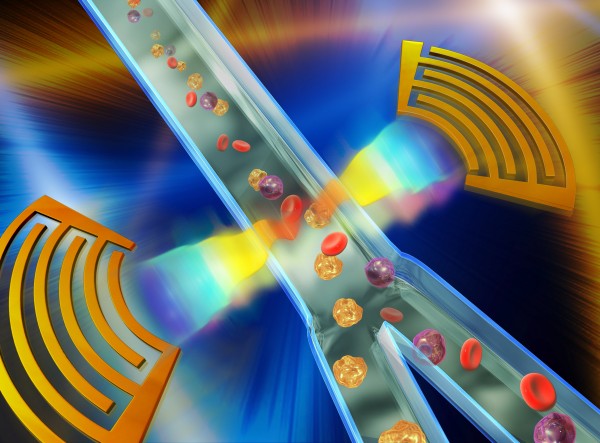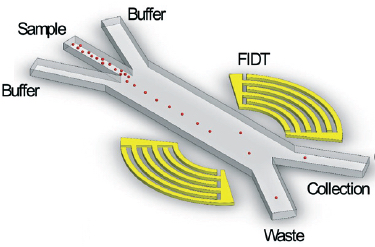A fast cell sorter shrinks to cell phone size
October 6, 2015

An artist’s conception of an acoustic cell sorter is the cover image on the current issue of Lab on a Chip (credit: Huang Group/Penn State)
Penn State researchers have developed a new lab-on-a-chip cell sorting device based on acoustic waves that is capable of the kind of high sorting throughput necessary to compete with commercial fluorescence activated cell sorters, described in the cover story in the current issue of the British journal Lab on a Chip.
Commercial fluorescence activated cell sorters have been highly successful in the past 40 years at rapidly and accurately aiding medical diagnosis and biological studies, but they are bulky and too expensive ($200,000 -$1,000,000) for many labs or doctors’ offices.
“The current benchtop cell sorters are too expensive, too unsafe, and too high-maintenance. More importantly, they have very low biocompatibility. The cell-sorting process can reduce cell viability and functions by 30–99 percent for many fragile or sensitive cells such as neurons, stem cells, liver cells and sperm cells,” said Tony Jun Huang, Penn State professor of engineering science and mechanics and the paper’s corresponding author. “We are developing an acoustic cell sorter that has the potential to address all these problems.”
High-speed sorting

Schematic of the standing surface acoustic waves (SSAWs)-based sorter excited by focused interdigital transducers (FIDTs) (credit: Liqiang Ren et al./Lab on a Chip)
Microfluidic cell sorters are a promising new tool for single cell sequencing, rare cell isolation, and drug screening. However, many of them operate at only a few hundred cells per second, far too slow to compete with commercial devices that operate on the order of tens of thousands of operations per second. The Penn State system can sort about 3,000 cells per second, with the potential to sort more than 13,000 cells per second.
The speed is generated by using focused transducers to create standing surface acoustic waves (SSAWs). When the waves are not focused, the acoustic field spreads out, slowing the sorting process. The narrow field allows the sorting to take place at high speed while gently manipulating individual cells.
“Our high-throughput acoustic cell sorter is expected to maintain cell integrity by preserving not only high viability, but also other cellular features such as gene expression, post translational modification, and cell function,” said Huang.
“The acoustic power intensity and frequency used in our device are in a similar range as those used in ultrasonic imaging, which has proven to be extremely safe for health monitoring, even during various stages of pregnancy. With the gentle nature of low-power acoustic waves, I believe that our device has the best chance in preserving cell integrity, even for fragile, sensitive cells. Such an ability is important for numerous applications such as animal reproduction, cell immunotherapy and biological research.”
Because the device is built on a lab-on-a chip system, it is both compact and inexpensive — about the size and cost of a cell phone in its current configuration. With the addition of optics, the device would still be only as large as a book.
The acoustic cell sorter was fabricated in Penn State’s Nanofabrication Laboratory using standard lithography techniques and co-developed with Ascent Bio-Nano Technologies and the National Heart, Lung, and Blood Institute, a part of the National Institutes of Health.
In future work, the researchers plan to integrate their acoustic cell-sorting unit with an optical cell-detecting unit, with the goal of increasing throughput to 10,000 events per second.
Abstract of A high-throughput acoustic cell sorter
Acoustic-based fluorescence activated cell sorters (FACS) have drawn increased attention in recent years due to their versatility, high biocompatibility, high controllability, and simple design. However, the sorting throughput for existing acoustic cell sorters is far from optimum for practical applications. Here we report a high-throughput cell sorting method based on standing surface acoustic waves (SSAWs). We utilized a pair of focused interdigital transducers (FIDTs) to generate SSAW with high resolution and high energy efficiency. As a result, the sorting throughput is improved significantly from conventional acoustic-based cell sorting methods. We demonstrated the successful sorting of 10 μm polystyrene particles with a minimum actuation time of 72 μs, which translates to a potential sorting rate of more than 13800 events per second. Without using a cell-detection unit, we were able to demonstrate an actual sorting throughput of 3300 events per second. Our sorting method can be conveniently integrated with upstream detection units, and it represents an important development towards a functional acoustic-based FACS system.